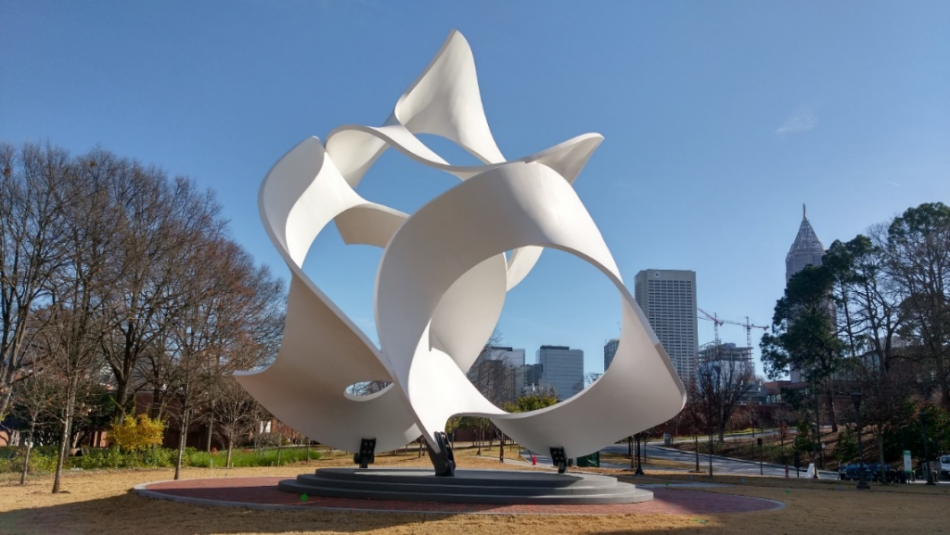Atlanta Architect John Portman Has Final Sculpture On Display At Georgia Tech Posthumously

Atlanta architect John
Portman’s final work, Koan, now has a permanent home on the campus of Georgia Tech University.
Portman Architects
The great architect and artist John Portman was a significant influence on the look of Atlanta with his dozens of landmark buildings. He also excelled in sculpture and paintings, examples of which still adorn the interior spaces of his architecture. Before his passing in 2017 at the age of 93, the artist conceived one more ambitious final sculpture, which his faithful collaborators would go on to see completed this year.
Portman’s final work, “Koan,” now has a permanent home on the campus of Georgia Tech, where Portman himself attended. It stands 40 feet tall, constructed over years in an adventurous alliance between a luxury bath company, a boat manufacturer, and supercomputers at the School of Aerospace Engineering at Georgia Tech. Portman’s lifelong collaborator Stanley Mickey Steinberg, along with President and Chief Design Officer at MTI Baths Russell Adams, joined “City Lights” Senior Producer Kim Drobes to talk about the grand project and how it honors the vision and philosophy of its designer.
Steinberg told the story of how Portman was called on to bring more art into the environment through which Georgia Tech’s students passed every day. The artist felt strongly that creativity should be an essential part of a serious engineer’s skill set, and brought that conviction to the new project. According to Steinberg, Portman said, “This piece has to talk to people. It’s got to mean something, it’s not just another meaningless sculpture.”
Georgia Tech’s website describes “koans” as “paradoxes, riddles, or dialogues meant to shake up our logical, rational minds.” On the sculpture’s title, Steinberg said, “It’s a word that comes from the Buddhist religion … The priests, they sit around in a circle and they discuss a subject or a thing, and they spend days, if necessary, looking for truth.”
The design that resulted from these contemplations gives viewers just such a sense of riddle, bending forms in ways that trick the eye and seem to shift with changing light patterns.
“It’s three-round wings, let’s call them, and they’re put on top of each other, working together, tied together,” said Steinberg. “The way John designed it … the three shapes are identical, except where they come to touch each other. But he broke each one into two parts, and those two parts are identical — we can make them out of the same mold. So each one of those circles is made out of two identical pieces, and you wouldn’t know that looking at it. You can only see it if we would take a model and cut it up. You have no starting point. You have no straight line anywhere on that piece.”
Originally a modest 12 feet in height, Portman’s concept vastly expanded in scale and ambition as he played with design and ideas for materials. After his passing, the collaborators that carried his vision forward ran into challenges. “We couldn’t make that sculpture out of the materials you normally do,” said Steinberg. “We’re in an area where we have hurricanes. We need to be able to take the wind, and those three things are sails. You put ‘em upright, and they’re like big sails … The only material that anybody knew that was strong enough, was carbon fiber. That’s what they build airplane wings out of, and spaceships.”
Naturally, the team and computers at Tech’s School of Aerospace Engineering came to the rescue. As structural schematics were settled, Steinberg and Adams turned to the question of how these massive shapes could be physically constructed. Adams’s company, MTI Baths, played a crucial role.
“We’re used to doing custom bathtubs and custom showers, custom bathing products, but nothing on this level at all. The original 21-foot sculpture we were going to build all in-house at MTI, but when it became 40 feet, that’s when we had to look to the outside,” said Adams.
“We had to find a much, much larger milling machine, and we looked into the boating industry, and we found a company that makes 50-foot powerboats out of carbon fiber … In this case, they were able to build these two molds one piece at a time, in this giant machine,” said Adams.
For the perfect exterior finish, Portman had already laid out his preferences. “We were building shower panes for the Hotel Indigo in Atlanta, and we were building the shower panes out of our material we call ‘sculpture stone,’ which is a solid surface material -it’s ground minerals and resin, engineered stone, basically. And he liked that surface a lot,” said Adams. “That’s what he wanted the feel and the look of the outside of the sculpture to be.”
“I couldn’t have done it without Russell and his people,” said Steinberg. “We had to figure out, collectively, how to build it, and that was a two-year process.”
Now finally complete, “Koan” stands in the center of Georgia Tech’s campus, appropriately next to the College of Design. Adams described the experience of moving in the sculpture’s space. “When you walk around the sculpture, even though it’s three rings that are identical, you can’t tell,” said Adams. “And when you walk around, it looks like it’s moving, and they all look a little bit different. Also, the light from the sun comes into play, and the shadows change it a bit. Mr. Portman had told me that he wanted the students to walk around it, walk through it, and experience it differently from different angles.”
“We just couldn’t be more proud to work with Mr. Portman on his final sculpture,” said Adams. “He pretty much designed the skyline of Atlanta, and to be able to work with him on his final sculpture was amazing.”








